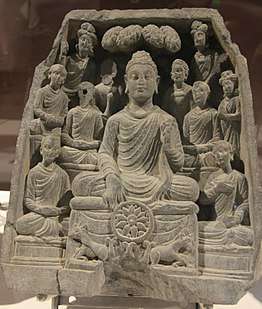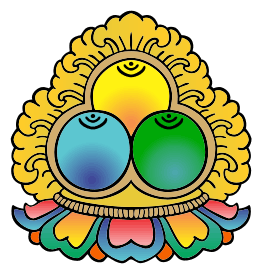Refuge (Buddhism)
Buddhists take refuge in the Three Jewels or Triple Gem (also known as the "Three Refuges").

| Part of a series on |
| Buddhism |
|---|
 |
|
|
|
Buddhist texts
|
|
Practices
|
|
|
| Translations of Refuge (Buddhism) | |
|---|---|
| Sanskrit | śaraṇa (शरण) |
| Pali | saraṇa (සරන ) |
| Bengali | শরন (Shôrôn) |
| Burmese | သရဏ (Tharana) |
| Chinese | 皈依 (Pinyin: Guīyī) |
| Japanese | 帰依 (rōmaji: kie) |
| Khmer | សរណៈ (Saranak) |
| Korean | 귀의 (RR: gwiui) |
| Thai | สรณะ, ที่พึ่ง ที่ระลึก RTGS: sarana, thi phueng thi raluek |
| Vietnamese | Quy y |
| Glossary of Buddhism | |
The Three Jewels are:
- The Buddha, the fully enlightened one
- The Dhamma, the teachings expounded by the Buddha
- The Sangha, the monastic order of Buddhism that practice Dharmas.
Refuge is common to all major schools of Buddhism. Pali Texts employ the Saranagamana[1] referenced in the Khuddaka Nikaya of the Tipitaka.
The initial chant consists of:
Buddham Saranam Gacchami
Dhammam Saranam Gacchami
Sangham Saranam Gacchami
Faith
Faith is an important teaching element in both Theravada and Mahayana traditions. In contrast to perceived Western notions of faith, faith in Buddhism arises from accumulated experience and reasoning.
In the Kalama Sutta, the Buddha explicitly argues against simply following authority or tradition, particularly those of religions contemporary to the Buddha's time.[2] There remains value for a degree of trusting confidence and belief in Buddhism, primarily in the spiritual attainment and salvation or enlightenment. Faith in Buddhism centres on belief in the Three Jewels.
Precepts
Lay followers often undertake five precepts in the same ceremony as they take the refuges.[3][4] Monks administer the precepts to the laypeople, which creates an additional psychological effect.[5] The five precepts are:
- to refrain from killing;[6][7][8]
- to refrain from stealing;[6][7][8]
- to refrain from lying;[6][7][8]
- to refrain from improper sexual conduct;[6][7][8]
- to refrain from consuming intoxicants.[6][7][8]
In Early Buddhist Texts, the role of the five precepts gradually developed. First of all, the precepts were combined with a declaration of faith in the triple gem (the Buddha, his teaching and the monastic community). Next, the precepts developed to become the foundation of lay practice.[9] The precepts were seen as a preliminary condition for the higher development of the mind.[10] At a third stage in the texts, the precepts were actually mentioned together with the triple gem, as though they were part of it. Lastly, the precepts, together with the triple gem, became a required condition for the practice of Buddhism, as lay people had to undergo a formal initiation to become a member of the Buddhist religion.[11] When Buddhism spread to different places and people, the role of the precepts began to vary. In countries in which Buddhism was adopted as the main religion without much competition from other religious disciplines, such as Thailand, the relation between the initiation of a lay person and the five precepts has been virtually non-existent, and the taking of the precepts has become a sort of ritual cleansing ceremony. In such countries, people are presumed Buddhist from birth without much of an initiation. The precepts are often committed to by new followers as part of their installment, yet this is not very pronounced. However, in some countries like China, where Buddhism was not the only religion, the precepts became an ordination ceremony to initiate lay people into the Buddhist religion.[12]
A layperson who upholds the precepts is described in the texts as a "jewel among laymen".[13]
Three Roots

In Tibetan Buddhism there are three refuge formulations, the Outer, Inner, and Secret forms of the Three Jewels. The 'Outer' form is the 'Triple Gem', (Sanskrit:triratna), the 'Inner' is the Three Roots and the 'Secret' form is the 'Three Bodies' or trikaya of a Buddha. These alternative refuge formulations are employed by those undertaking Deity Yoga and other tantric practices within the Tibetan Buddhist Vajrayana tradition as a means of recognizing Buddha Nature.
| Tibetan Buddhist Refuge Formulations | |||
| Outer or 'Three Jewels' | Buddha | Dharma | Sangha |
| Inner or 'Three Roots' | Lama (Guru) | Yidam (Ista-devata) | Khandroma (Dakini)[14] |
| Secret or 'Trikaya' | Dharmakaya | Sambhogakaya | Nirmanakaya |
| Three Vajras | Mind | Speech | Body |
| seed syllable | blue hum | red ah | white om |
Three refuge motivation levels are: 1) suffering rebirth's fear motivates with the idea of happiness, 2) knowing rebirth won’t bring freedoms motivated by attaining nirvana, while 3) seeing other’s suffering motivates establishing them all in Buddhahood.[15] Happiness is temporary, lifetimes are impermanent and ultimately refuge is taken until reaching unsurpassed awakening.[16]
See also
- Abhijñā
- Anussati
- Dharmapala
- Holy Spirit
- Pure land
- Titiksha
- Trikaya
Notes
- "Saranagamana".
- "Kalama Sutta: The Buddha's Charter of Free Inquiry". 4 February 2013. Archived from the original on 4 February 2013.CS1 maint: BOT: original-url status unknown (link)
- Getz 2004, p. 673.
- "Festivals and Calendrical Rituals". Encyclopedia of Buddhism. The Gale Group. 2004. Archived from the original on 23 December 2017 – via Encyclopedia.com.
- Harvey 2000, p. 80.
- "The Eight Precepts: attha-sila". www.accesstoinsight.org.
- "Uposatha Sila: The Eight-Precept Observance". www.accesstoinsight.org.
- Sāmi, Dhamma. "The 8 precepts". en.dhammadana.org.
- Kohn 1994, pp. 173–4.
- Terwiel 2012, p. 178.
- Kohn 1994, p. 173.
- Terwiel 2012, pp. 178–9, 205.
- De Silva 2016, p. 63.
- In Sarma traditions, this root is the Chokyong (Skt: dharmapāla, Wylie: chos-kyong)
- Rinpoche, Patrul. Words of My Perfect Teacher: A Complete Translation of a Classic Introduction to Tibetan Buddhism (Sacred Literature) (2011 ed.). Yale University Press. pp. 176–177. ISBN 0-300-16532-3.
- Dorje, Choying Tobden; Zangpo, Ngawang (June 2, 2015). The Complete Nyingma Tradition from Sutra to Tantra, Books 1 to 10: Foundations of the Buddhist Path (First ed.). Snow Lion. pp. 224–227. ISBN 1-55939-435-8.
References
- De Silva, Padmasiri (2016), Environmental Philosophy and Ethics in Buddhism, Springer Nature, ISBN 978-1-349-26772-9
- Getz, Daniel A. (2004), "Precepts", in Buswell, Robert E. (ed.), Encyclopedia of Buddhism, Macmillan Reference USA, Thomson Gale, ISBN 978-0-02-865720-2, archived from the original on 23 December 2017
- Harvey, Peter (2000), An Introduction to Buddhist Ethics: Foundations, Values and Issues (PDF), Cambridge University Press, ISBN 978-0-511-07584-1
- Kohn, Livia (1994), "The Five Precepts of the Venerable Lord", Monumenta Serica, 42 (1): 171–215, doi:10.1080/02549948.1994.11731253
- Sangharakshita, Going for Refuge. Windhorse Publications. (1997)
- Terwiel, Barend Jan (2012), Monks and Magic: Revisiting a Classic Study of Religious Ceremonies in Thailand (PDF), Nordic Institute of Asian Studies, ISBN 9788776941017, archived (PDF) from the original on 19 August 2018
External links
- A Buddhist View on Refuge
- Refuge: A Safe and Meaningful Direction in Life by Dr. Alexander Berzin
- Refuge Vows (including commentary by Dr. Alexander Berzin)
- Taking the refuges and precepts online by Bhikkhu Samahita
- Vajrayana refuge prayer audio
- The Threefold Refuge (tisarana)
- Five Precepts (pañca-sila)
- Abhisanda Sutta (Anguttara Nikaya)
- Saranagamana (Khuddakapatha)
- Going for Refuge and Taking the Precepts by Bhikkhu Bodhi
- Refuge: An Introduction to the Buddha, Dhamma and Sangha by Thanissaro Bhikkhu
- Refuge Tree Thangkas by Dharmapala Thangka Centre
- Ceremony for Taking Refuge and Precepts by Ven. Thubten Chodron
- The three jewels of Buddhism in relation to Anthroposophy. by Bruce Kirchoff